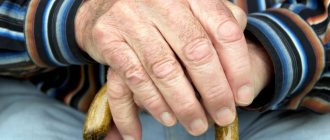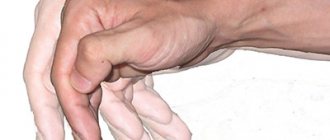Tremor is a fairly common disorder of motor function, the main symptoms of which are uncontrolled movements (shaking, vibration, trembling) of various parts of the body. The disease occurs as a result of constant involuntary muscle contractions, most often develops in older people, but can often affect adolescents. There are benign, postural and intention tremor.
Head tremor is characterized by “yes-yes” and “no-no” movements, manifests itself (intensifies) with severe excitement or at the time of drinking alcohol and is a sign of serious neuralgic disorders. Sometimes the disease is accompanied by trembling of the larynx and tongue, which causes speech impairment. The presence of tremor may indicate diseases such as Parkinson's disease, Wilson-Konovalov disease, mercury poisoning, kidney and liver failure. Symptoms of the disease vary in duration and severity.
Content:
- Pathogenetic causes of development.
- Clinical features:
- How to get rid of the disease:
2.1. Types of alcoholic tremors
3.1. Treatment at home with a doctor's call. 3.2. Therapy in a hospital. 3.3. How to treat the disease yourself.
Intoxication, which develops against the background of prolonged regular drinking, affects almost all internal organs. But it is the nervous system that suffers first. And first of all, we are talking about damage to individual brain structures and disruption of neuromuscular transmission. Alcohol tremor is one of the manifestations and consequences of long-term alcohol consumption. First, it occurs during the period of abstinence after binge drinking, then it is observed almost constantly, intensifying under the influence of alcohol or external stress factors.
Diagnosis of head tremor
First of all, it is necessary to establish the diseases that cause head shaking. As a rule, the development of tremor is based on a malfunction in the functioning of internal organs.
After clarifying the patient’s complaints, rapid video recording is carried out and tremor is checked using a tremograph (a special device that records tremor in 3 planes). Electromyography, which determines electrical muscle activity, is required.
Additionally, studies are prescribed to assess the general condition of the patient’s body, as well as the activity of internal organs (ultrasound examination, laboratory blood tests, magnetic resonance imaging). If necessary, the patient is recommended to visit specialists.
Pathogenetic causes of development
The occurrence of alcoholic tremor is due to the following mechanisms:
- Peripheral.
Appears due to involuntary, convulsive muscle contractions against the background of systemic intoxication with acetaldehyde, which is formed during the breakdown of ethyl alcohol in the liver. - Central.
Associated with the direct toxic effect of alcohol on areas of the brain responsible for coordination of movements and processes of muscle tension and relaxation (cerebellum, cortical structures).
A certain role in the development of pathology is also played by:
- persistent ischemia of the central and peripheral nervous system;
- hypovolemia;
- electrolyte and acid-base imbalance;
- violation of the filtration function of the liver;
- circulatory pathologies associated with impaired vascular tone, atherosclerosis, chronic hypertension;
- endocrine pathologies (especially thyroid diseases);
- deficiency of thiamine and other vitamins;
- metabolic disorders, etc.
In addition, alcohol is one of the risk factors for the development of degenerative neurological disorders. According to statistics, alcohol addicts more often suffer from Alzheimer's disease, parkinsonism, vegetative-vascular dystonia and other syndromes, which themselves are accompanied by tremors.
Other symptoms of Parkinson's disease
In addition to movement disorders, Parkinson's disease may cause a lot of other symptoms, some of which lead to maladaptation and disability:
- Increased salivation.
- Mental disorders - depression, psychosis, dementia, insomnia, hallucinations. These manifestations can be associated with the disease itself, or occur as side effects from its treatment.
- A speech disorder associated with the impossibility of normal functioning of the muscles of the speech apparatus.
- Dysfunction of the pelvic organs.
- Weight changes - from emaciation to obesity.
- Increased greasiness of skin and hair.
Without treatment, the symptoms of Parkinson's disease steadily progress, and within 15 years of the onset of the disease, about 90% of patients have disability. But modern methods of therapy (medical and surgical) make it possible to keep the situation under control, increase life expectancy and improve its quality in people with such problems.
Clinical features
Typical symptoms of the disease include:
- alcoholic hand tremor, which in the relatively early stages of binge drinking appears when trying to keep the hands in an outstretched, tense state; subsequently, trembling can occur at rest;
- unsteady, uncertain gait, dizziness, disorientation (especially in the dark);
- alcoholic head tremor, with the shaking usually affecting the lower jaw, eyelids, and tip of the tongue;
- severe chills and sweating.
As the disease progresses, the patient experiences difficulty even performing basic daily duties. It becomes difficult for him to get dressed or bring a filled cup or spoon to his mouth. Naturally, he is physically unable to engage in any professional activity.
Types of alcoholic tremors
By localization:
- focal, affecting one strictly defined anatomical area (for example, hand, jaw, tongue, etc.);
- segmental, when two or more adjacent parts of the body are involved in the pathological process;
- hemitremor, which is unilateral;
- generalized, spreading to the whole body.
According to the clinical picture:
- postural, which appears when trying to maintain a certain position (and when changing body position, the trembling may disappear);
- kinetic, which occurs during movement and intensifies when approaching the target;
- kinesiospecific, developing only during certain actions (for example, writing, typing on a computer, etc.);
- isometric, observed when trying to clench the hand into a fist or hold an object;
- resting tremor, when the trembling persists even when the muscles relax.
General symptoms
The main symptoms of hyperkinesis include motor acts performed by patients against their will, the so-called violent ones. Patients themselves describe them as the result of an irresistible desire that they cannot resist.
The list of symptoms representing hyperkinesis includes:
- frequent blinking and squinting of the eyes (tics);
- convulsive tilting or turning of the head;
- tremor of various parts of the body, most often the limbs;
- myoclonus – sudden muscle twitching of the arms or neck;
- chorea - arrhythmic movements of facial expressions, involuntary sounds arising from rapid contractions of the muscles of the larynx;
- ballism - sudden rotation of the hip or shoulder;
- Blapharospasm is a pathological closure of the eyelids, as one of the signs of various diseases.
Forms of hyperkinesis can vary from intermittently frequent to constant. Some patients manage to control certain forms of hyperkinesis (for example, tics) by force of will, but after a while the attack of violent movements manifests itself again with even greater force.
How to get rid of the disease
Alcohol tremors indicate a severe form of addiction. Therefore, it is important not only to eliminate the symptoms of the pathology, but also its cause.
Treatment at home with a doctor's call
To eliminate involuntary muscle contractions and avoid progression of the disorder to a generalized seizure, use:
- saline solutions, cocarboxylase, glucose;
- vitamins (necessarily thiamine, pyridoxine and cyanocobalamin);
- hepatoprotectors;
- means for activating cerebral and peripheral blood circulation, nootropic drugs;
- cardioprotectors;
- painkillers and antispasmodics.
Usually such treatment is sufficient to alleviate the patient's condition. If the tremor persists, the patient is additionally administered drugs from the group of benzodiazepines. They have a double effect: sedative and anticonvulsant.
Inpatient therapy
In any case, it is better to carry out detoxification in a clinical setting, but strict indications for hospitalization are:
- chronic diseases of the cardiovascular system;
- renal and/or liver failure;
- severe neurological pathologies (epilepsy, encephalopathy, recent stroke, history of neuroinfections, traumatic brain injuries);
- risk of developing a generalized seizure;
- signs of delirium, hallucinosis;
- use (in addition to alcohol) of drugs, strong sedatives.
In a hospital, the doctor has more opportunities to resolve the issue than to treat alcoholic tremors. The patient is under medical supervision at all times, basic vital parameters are monitored, and medications are administered almost around the clock.
In addition to medications, the clinic offers hardware detox procedures (ILBI, plasmapheresis). Excellent results are demonstrated by physiotherapy, laser or electromagnetic stimulation of biologically active zones on the body.
In a hospital, you can determine and how to treat the cause of alcoholic tremors - an uncontrollable desire to drink. After detoxification is completed, consultations with a psychotherapist begin, who motivates the patient to finally get rid of addiction.
How to treat the disease yourself
Doctors categorically warn against self-medication, taking any medications (and especially sedatives or anticonvulsants) without prior diagnosis and doctor’s prescriptions. But if for some reason the patient cannot go to a specialized hospital, doctors give several tips on how to alleviate their condition:
- completely eliminate alcohol;
- reconsider your diet and diet: you need to give up coffee, strong tea, and energy drinks;
- moderate physical activity is required (but not before bedtime);
- drink plenty of fluids (at least 1.5 liters of clean water per day);
- go to bed on time, before going to bed, avoid watching gadgets and movies - it is better to replace them with a walk in the fresh air.
But these are only temporary measures; final recovery from alcoholism requires complex long-term treatment and mandatory rehabilitation. But in parallel with addiction therapy, to eliminate alcoholic tremors, correction of concomitant neurological and metabolic disorders is also carried out.
Types of hyperkinesis
There are various criteria that are used to classify pathology. Thanks to them, the following types of hyperkinesis can be distinguished:
- childhood forms - hyperkinesis up to one year, in the age category from one to five, during puberty;
- by type of occurrence - spontaneous, reflex (reaction to external phenomena), actional (provoked by a certain condition), induced (can be controlled by the patient);
- along the flow – constant (tremors) and episodic (tics);
- by speed of movement - fast and slow;
- by localization - hyperkinesis of the face, limbs, tongue;
- by origin - a distinction is made between primary (congenital) and secondary hyperkinesis acquired as a result of injury or taking medications.
Hyperkinesis in cerebral palsy in children begins to appear at the age of 1.5-2 years. Children with this pathology have difficulty coordinating their movements, which often look like pushing, jerking and twisting. Repetitive movements can be fast and rhythmic or, conversely, slow and erratic.
Hyperkinesis in cerebral palsy may be accompanied by swallowing disorders, speech delays and disorders, and lability of the emotional system.
Literature:
- A manual on narcology for doctors and paramedics of primary medical care / A. A. Churkin, T. V. Klimenko. / Moscow ; Khanty-Mansiysk / Health and Society, 2006 (Cheboksary: IPK Chuvashia). — 173 p.
- Tremor: pathogenesis, features of the clinical picture, treatment. Ivanova E.O. / Neurological journal. 2013
- Tremor: classification, clinical characteristics. Govorova T.G. / Journal Consilium Medicum 2022
Need some advice?
OR CALL A DOCTOR
CALL!
+7
Treatment of head tremors
The choice of therapeutic tactics is based on the results of examination of the patient, diagnostic studies, as well as taking into account individual factors: age, type of disease causing head tremors and personal characteristics of the patient. You need to know that head tremors are quite difficult to treat. The benign form of tremor does not require intensive therapy. As a rule, patients are prescribed sedative medications.
Progressive twitching is corrected with medications such as antelepsin, metoprolol, atenolol, propranolol, primidone. Despite the fact that treatment of head tremors with these medications does not give impressive results, doctors do not cancel this point of treatment.
In almost every case, vitamin complexes are prescribed, including intramuscular injections of vitamin B6.
Additional relaxation is provided by the use of auxiliary methods: breathing exercises, Pilates, yoga, auto-training, swimming, therapeutic baths.
Some patients with head tremors require the help of a qualified psychologist, whose practical advice teaches them to relax and cope with emotional stress.
To prevent possible exacerbations of the pathology, the patient needs to get rid of bad habits, include healthy foods in the diet, and avoid drinking coffee. In addition, you need to adhere to a measured and healthy lifestyle, avoid stressful situations, physical and emotional stress.
Non-standard approach
In Eastern medicine, finger yoga is widely practiced, the asanas of which are called mudras. If you have a head tremor, you need to do “exercises” daily, consisting of two exercises:
- Wind mudra. It is necessary to press the tip of the index finger to the base of the thumb (meaning the fingers of one hand). Use your thumb to help your index finger, lightly pressing it from above. The main task of the unused fingers is to remain relaxed and as straight as possible.
- Mudra of "life". Three fingers should be joined together: the thumb, ring and little finger. The index and middle fingers remain straight.
You can practice mudras throughout the day, setting aside some time for this in the office, in line, or on public transport. But at least one “charging” must be complete, that is, carried out:
- in a calm, secluded environment;
- in a relaxed state of mind (work and personal worries should be put out of your head for a while);
- with complete focus on the desired goal.
You can combine mudra classes with yoga training. Both of these systems are aimed at calming the mind and normalizing the functioning of all body functions.
Head tremor is an unpleasant, but surmountable phenomenon. The sooner measures are taken to get rid of this pathology, the more noticeable the result will be. Therefore, the first thing you need to do is go to the doctor, and then decide whether to take medications or limit yourself to folk remedies.




